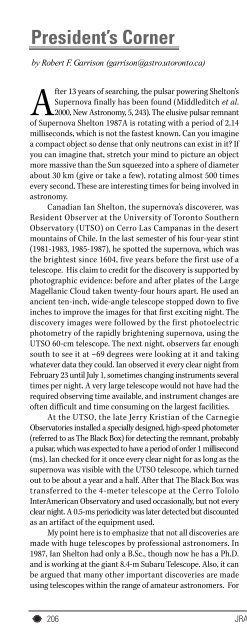I N S I D E T H I S I S S U E
insidethisissue - The Royal Astronomical Society of Canada
insidethisissue - The Royal Astronomical Society of Canada
- No tags were found...
Create successful ePaper yourself
Turn your PDF publications into a flip-book with our unique Google optimized e-Paper software.
Editorialby Wayne A. Barkhouse, Editor-in-ChiefMathematically speaking, the end ofthe current millennium is upon us.This is a natural time to reflect uponthe changes that have occurred in our societyduring the past one thousand years and toimagine what will happen in the future.Specifically, how has our knowledge ofastronomy evolved since AD 1000? What havebeen the most significant astronomicaldiscoveries during this period? What will theJournal editor write (or communicate bythought?) in December, AD 3000 about thepast 1000 years? We are alive at a special timein human history to be able to witness thebeginning of the new millennium.Looking back, what was the extent ofour knowledge of astronomy in AD 1000?Night-sky observations had been recordedfor centuries and many cultures developedindependent and sophisticated calendars.Greek science flourished for almost 1000 yearsfrom 600 BC and included quantitativemeasurements of the size of the Earth andrelative distances of the Moon and Sun.Geocentric models were developed to calculatethe positions of the planets. The model ofPtolemy was still in use by the Arabs in AD1000.The first significant breakthrough inhuman understanding of our place in theuniverse (since AD 1000) was the CopernicanRevolution — the notion that the Earth is notthe centre of the universe but instead orbitsthe Sun which is (near) the centre. Althoughone of the Greek philosophers, Aristarchus,had suggested this idea long before Copernicus,it was not until the late 16 th century that itfinally started to take root. The demotion ofthe Earth from the special place at the centreto being “just another planet” was one of themost important paradigm shifts to occur inthe history of the human race and was truly“revolutionary.”The next major advance took place inthe early 1600’s with the Dutch invention ofthe telescope and its use by Galileo forastronomical study. His discovery of the phasesof Venus, the moons of Jupiter, and the factthat the Milky Way could be resolved intothousands of stars showed how technologycould be used to improve our understandingof nature. Also during this time, Keplerdeveloped his three laws of planetary motion,laying important mathematical groundwork.The Copernican Revolution culminatedin 1687 with Newton’s publication of thePrincipia, unifying the work of Galileo andKepler in a set of dynamical laws that wereapplicable to objects on Earth or in the heavens.The motions of projectiles and planets couldnow be understood using a model that wasphysically and mathematically sound.In the last one hundred years, the paceof acquiring knowledge has increaseddramatically. Einstein’s General Theory ofRelativity initiated a major revolution in theway we view gravity and, along with his SpecialTheory of Relativity, superseded the work ofNewton. This occurred at a time whentechnology was beginning to make possiblethe building of large telescopes, which woulddramatically extend the observational frontiers.Hubble’s extragalactic work demonstratedthat the Milky Way was but one of many “starsystems” spread throughout an expandinguniverse, and could be understood in largepart by Einstein’s equations of General Relativity.In the 1930’s Hans Bethe discovered thatthe source of power for the Sun, and thereforeall stars, was nuclear fusion. With this theoreticalfoundation and the remarkable progress gainedin understanding the spectroscopicobservations, the field of stellar astronomyapproached a level of maturity that was onlydreamed of in the 19 th century.In the later half of the 20 th century, themost profound achievements have been broughtabout by our relentless drive to understandthe workings of our universe on the largestscales. The discovery in the 1960’s of the birthpang of the Big Bang, the cosmic microwavebackground, put a nail in the coffin of themajor rival theory at that time and placedcosmology on a strong scientific foundation.Today we find ourselves in a veryinteresting period. Observations indicate thatthe majority of matter in the universe doesnot radiate like ordinary matter but is instead“dark.” Also, recent high-redshift supernovaeand, independently, measurements of thefluctuations in the cosmic microwavebackground, imply that approximately 70%of the mass-energy of our universe may be insome form of a “repulsive-force” that causesthe rate of the expansion of the universe toincrease with time.What wondrous and profound discoverieswill occur in astronomy and astrophysics inthe next millennium? What will the editor ofthe Journal in December, AD 3000, write asour most significant accomplishment in thepast 1000 years? Please send me your thoughts,and I will list some of the most interestingones in a future issue.Happy holidays and a very happy newmillennium!OMISSIONIn the August/October issue we neglectedto credit the GA group photo (printed onthe cover and on page 161) to MurrayPaulson, Edmonton Centre.208JRASC December / décembre 2000
















